Gas Sensors for the Chemical Industry: How to Choose the Right One
Leaks don’t always come with a warning. In chemical plants, even a small unnoticed release can lead to toxic exposure, fire, or downtime. That’s why choosing the right gas sensor chemical industry solution isn’t just important — it’s essential for safety and process control.

Why Industrial Gas Leak Detection Needs Regulation
Industrial facilities handle gases that can ignite, poison, or suffocate. Without regular calibration and maintenance, gas detection becomes unreliable — and potentially dangerous.. Governments and industry bodies enforce rules to ensure:
- Sensors respond fast enough to prevent exposure
- Devices operate safely in hazardous areas
- Equipment integrates with facility-wide alarms
- Workers receive clear and early warnings
Identify Gases Present in Your Facility
Every chemical plant handles specific substances. Some are flammable (like hydrogen), others toxic (like chlorine or ammonia). A sensor not designed or calibrated for the specific target gas will not detect it, except in cases of cross-sensitivity.
Before purchasing any equipment, define:
Before purchasing any equipment, define:
- Types of gases in use or generated
- Their concentration levels
- Whether they are explosive, corrosive, or asphyxiating
- Exposure limits set by regulations
Understand Environmental and Process Conditions
Gas detectors must perform reliably in field conditions, not lab conditions. The gas detectors for chemical plants you select should withstand:
- High humidity and temperature fluctuations
- Dust, solvents, or corrosive fumes
- Places with pressure changes or poorly ventilated enclosed spaces
- Electromagnetic interference from nearby equipment
Compare Sensor Technologies for the Right Fit
Each gas sensor type offers specific benefits. The most common choices include:
- Electrochemical: Suitable for detecting toxic gases; accurate but sensitive to temperature.
- Infrared (IR): Ideal for flammable hydrocarbons; stable and less prone to contamination.
- Catalytic bead: Low cost for flammable gas detection but can degrade in harsh environments.
- Photoionization (PID): Good for low-concentration VOCs but not suitable for all gas types.
Critical Selection Factors for Gas Detectors
Here’s a checklist to guide your decision:
- Gas type compatibility
- Sensor lifespan and calibration needs
- Alarm thresholds and response time
- Installation method (fixed, portable, wireless)
- Integration with DCS or safety systems
- Compliance with ATEX, IECEx, or local safety standards
- Availability of service and spare parts
Typical Mistakes to Avoid
When selecting sensors, companies often focus only on price or delivery time. This approach causes problems later. The most common mistakes include:
- Using sensors for the wrong gas type
- Installing detectors in the wrong locations
- Skipping calibration schedules
- Ignoring sensor degradation in corrosive environments
Where and How to Install Gas Sensors
To be effective, gas detectors must be placed in the right locations. Use these basic guidelines:
- Near potential leak sources: pipelines, valves, storage tanks
- At gas-specific height: lighter gases (e.g., hydrogen) near ceilings, heavier gases (e.g., chlorine) near floors
- In enclosed or poorly ventilated zones
- Along airflow routes where gases may spread
- Where personnel exposure is likely
Key Benefits of Reliable Gas Detection in Chemical Plants
A proper sensor system ensures:
- Early leak detection before dangerous concentrations accumulate
- Reduced risk of fire, explosion, or exposure
- Compliance with health and safety regulations
- Improved insurance coverage and audit readiness
- Greater confidence among operations staff
Step-by-Step Approach to Sensor Selection
Use this method to streamline your decision:
- Define your gases and plant conditions
- Select sensor technology based on gas type
- Ensure certifications match your safety zone classification
- Match output signals with your control systems
- Plan for long-term maintenance and calibration
Think Long-Term, Not Just Compliance
A well-chosen gas sensor chemical industry setup doesn’t just meet today's regulations. It helps prevent tomorrow’s problems. Reliable gas detectors for chemical plants protect your people, processes, and productivity — but only if chosen with precision and maintained with care.